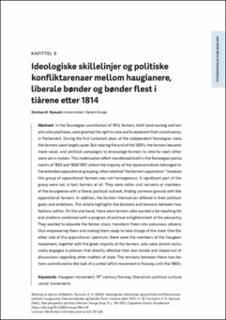| dc.contributor.author | Nymark, Kristian Holen | |
| dc.date.accessioned | 2023-08-09T13:25:36Z | |
| dc.date.available | 2023-08-09T13:25:36Z | |
| dc.date.created | 2023-08-07T11:00:52Z | |
| dc.date.issued | 2023 | |
| dc.identifier.citation | Nymark, K. H. (2023). Ideologiske skillelinjer og politiske konfliktarenaer mellom haugianere, liberale bønder og bønder flest i tiårene etter 1814. I E. M. Farstad & K. H. Nymark (Red.), Nye perspektiv på Hans Nielsen Hauge (Kap. 9, s. 183–201). Cappelen Damm Akademisk. | en_US |
| dc.identifier.isbn | 9788202791780 | |
| dc.identifier.uri | https://hdl.handle.net/11250/3083223 | |
| dc.description.abstract | In the Norwegian constitution of 1814, farmers, both land-owning and tenants who paid taxes, were granted the right to vote and to represent their constituency in Parliament. During the first turbulent years of the independent Norwegian state, the farmers were largely quiet. But nearing the end of the 1820’s, the farmers became more vocal, and political campaigns to encourage farmers to vote for each other were set in motion. This mobilisation effort manifested itself in the Norwegian parliaments of 1833 and 1836/1837, where the majority of the representatives belonged to the extended oppositional grouping, often labelled “the farmer’s opposition.” However, this group of oppositional farmers was not homogenous. A significant part of the group were not, in fact, farmers at all. They were rather civil servants or members of the bourgeoise with a liberal political outlook, finding common ground with the oppositional farmers. In addition, the farmers themselves differed in their political goals and ambitions. This article highlights the divisions and tensions between two factions within. On the one hand, there were farmers who wanted a far-reaching liberal platform combined with a program of political enlightenment of the peasantry. They wanted to educate the farmer class, transform them into conscious citizens, thus empowering them and making them ready to take charge of the state. One the other side of the oppositional spectrum, there were the members of the Haugean movement, together with the great majority of the farmers, who were almost exclusively engaged in policies that directly affected their own estate and stayed out of discussions regarding other matters of state. The tensions between these two factions contributed to the lack of a united leftist movement in Norway until the 1860’s. | en_US |
| dc.language.iso | nob | en_US |
| dc.relation.ispartof | Nye perspektiv på Hans Nielsen Hauge | |
| dc.relation.uri | https://press.nordicopenaccess.no/index.php/noasp/catalog/book/190#chapters | |
| dc.rights | Navngivelse 4.0 Internasjonal | * |
| dc.rights.uri | http://creativecommons.org/licenses/by/4.0/deed.no | * |
| dc.title | Ideologiske skillelinjer og politiske konfliktarenaer mellom haugianere, liberale bønder og bønder flest i tiårene etter 1814 | en_US |
| dc.type | Chapter | en_US |
| dc.description.version | publishedVersion | en_US |
| dc.rights.holder | © 2023 Kristian Holen Nymark. | en_US |
| dc.source.pagenumber | 183-201 | en_US |
| dc.identifier.doi | https://doi.org/10.23865/noasp.190.ch9 | |
| dc.identifier.cristin | 2165201 | |
| cristin.ispublished | true | |
| cristin.fulltext | original | |
| cristin.qualitycode | 1 | |

